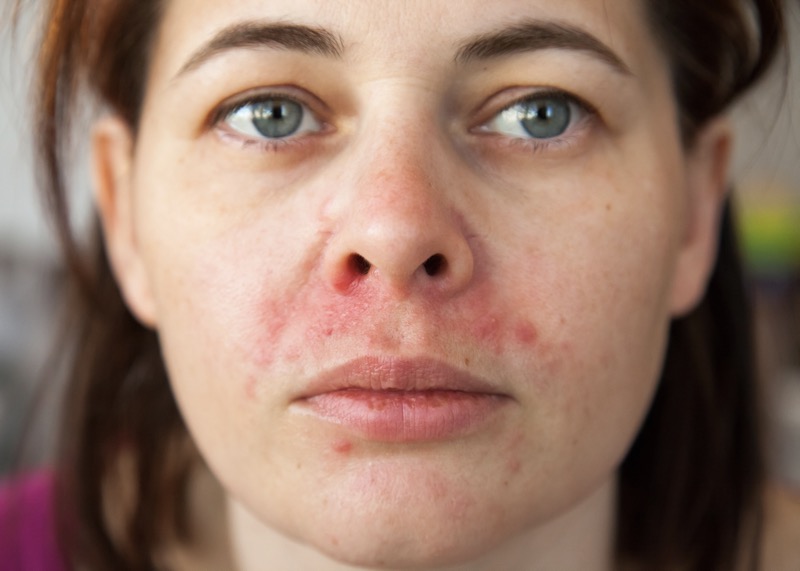Are you struggling with perioral dermatitis? You’re not alone. This frustrating skin condition can be challenging to treat, but natural remedies can provide support. This article explores the causes and underlying drivers and discusses some effective, natural approaches to managing perioral dermatitis and restoring your skin’s health.
Symptoms
Perioral dermatitis (POD) first presents with small, pale pink bumps around the mouth (excluding the lips), nasal folds, or eyes. These then morph into vesicles or papules, usually with clear fluid, often misdiagnosed as acne vulgaris. Unlike acne, there are no comedones (plugged pores). As the condition progresses, the skin becomes red and inflamed, often with an itching and burning sensation. The skin feels dry and tight and flakes in the affected areas (1,2).
Women are more affected by POD than men, and it may emerge during times of hormonal transitions such as puberty, pregnancy and perimenopause. It is also seen in younger children (3).
What else could it be?
- Acne vulgaris
- Acne rosacea
- Seborrheic dermatitis
- Herpetic dermatitis
- Angular cheilitis
- Eczema
- Allergic contact dermatitis
Causes
The cause of POD is not fully understood, but it involves a complex interplay of skin barrier dysfunction, skin microbiome imbalances, genetic predisposition, and hormonal and immune factors (1).
Skin barrier dysfunction
Genetics, hormonal shifts, and corticosteroid use can cause changes to the skin barrier. A damaged barrier increases trans epidermal water loss and allows sensory irritants to penetrate, which in turn causes immune activation and perifollicular inflammation, swelling, and redness.
Skin microbiome
An imbalanced skin microbiome can cause an overgrowth of microorganisms, which contributes to inflammation and changes to the skin barrier. Fusobacteria, Demodex folliculorum, and candida overgrowth have all been implicated in POD. There may be links to dysbiotic oral and gut microbiomes (1,5).
Hormonal factors
Women have higher rates of POD, and it often presents around times of hormonal shifts such as puberty, pregrancy and perimenopause. The underlying mechanisms are unclear but may relate to hormonal impacts on the skin barrier and immune system.
Corticosteroids
Corticosteroids are well recognised as both a trigger and an exacerbator of POD. Residues from inhaled (salbutamol for asthma or nasal sprays), oral, or topical corticosteroids decrease epidermal lipids (ceramides), causing skin barrier dysfunction. They also disrupt the microflora of the hair follicle, leading to overgrowth of the organisms mentioned above (6).
Topical steroids are often (erroneously) prescribed in the early stages of POD, and while they may provide initial improvements, there is often a rebound flaring, leading to a dependency cycle (7).
Exacerbators
The following are not causative on their own, but they can exacerbate POD symptoms.
- Fluoride containing toothpastes
- Soaps
- Personal care products containing sodium laurel sulphate
- Skincare with fragrances, essential oils
- Chewing gums
- Heavy moisturiser, night creams
- Retinoids and other skin care actives
- Mask wearing
Natural treatment considerations
Perioral dermatitis can be a challenging condition to treat. A holistic, personalised approach targeting the individual patient drivers gives the best result. The following are some natural perioral dermatitis treatment considerations. I recommend working with a healthcare professional to get the right approach for you
Treatment targets in POD include
- Supporting skin barrier health
- Improving microbiome (skin, oral and gut)
- Reduce systemic inflammation
- If using – transition off topical corticosteroids
Topical
Less is more topically when it comes to healing a skin barrier. In the flared stage –
- Avoid topical corticosteroids
- Use a simplified skincare routine with either tepid water or a gentle, fragrance-free, pH-balanced cleanser and moisturiser
- Choose a dermatologist-grade sunscreen.
- Although it’s tempting to want to use a thick, moisturising night or eye creams, this needs to be avoided
- No face mask peels or exfoliation
- If possible, limit makeup use
- Remove any of the exacerbators listed above
- If you use inhaled or nasal corticosteroids, rinse the surrounding area with water after each use to remove any residue.
- Some people find LED light therapy helpful
- Avoid direct sunlight exposure. Wear a wide-brimmed hat when outdoors.
Diet
A nutritious diet is foundational for skin health. While particular foods are often promoted as “skin foods,” the real issue is the overall shape of the diet.
Include daily
- Two serves of fruit and five serves of vegetables
- Lean animal protein/vegetable protein
- 1-2 serves of whole grains
- 30-40g of dietary fibre
- Healthy fats from nuts, seeds, extra virgin olive oil, avocado, oily fish
- Adequate hydration, mainly from water
- Fermented foods like sauerkraut, kimchi, kefir, miso, tempeh if tolerated
Limit
- Ultra-processed foods
- Refined sugar
- Alcohol
- Any foods you have intolerances to
Supplements for perioral dermatitis
The following supplements may be helpful to treat and manage POD.
L-histidine
The amino acid L-histidine can be helpful, especially in those who are prone to eczema and/or asthma and may have a genetic filaggrin deficiency. Filaggrin is a protein involved in the integrity and strength of the skin barrier (8).
Collagen
Hydrolysed collagen peptides have been shown to improve skin barrier function by stimulating the body’s production of Type 1 collagen and elastin. They also increase hyaluronic acid production, which improves skin hydration (9,10).
Zinc
Zinc is an essential mineral for skin health. It plays roles in collagen, keratin formation, and wound healing. It can be used orally or incorporated topically (after POD flares are under control). Zinc also has anti-inflammatory actions, decreasing TNF alpha and interleukin-6 (11).
Evening Primrose Oil
The gamma-linolenic acid in evening primrose oil is an essential omega-6 fatty acid with anti-inflammatory properties and supports ceramide synthesis. It has also been shown to enhance skin barrier function (12).
Prebiotics
Galacto-oligosaccharides (GOS) are prebiotic fibres that, when taken orally, modulate the skin microbiome and immune system via the gut-skin axis. A small randomised control trial showed that 12 weeks of consumption of GOS improved skin hydration, increased filaggrin formation, and reduced inflammation (13).
How long to see results with perioral dermatitis treatment?
Depending on the stage of the condition, healing times for POD vary. If managed well in the early stage, remission can be achieved in 4-6 weeks. If it is more severe, it may take 12-18 months.
If you enjoyed this article, you might also find the following helpful.
Natural treatments for dry skin
A guide to using zinc for acne and skin health
References available on request

Need help with your skin?
Norelle Hentschel is an experienced Naturopath with a clinic in Stones Corner, Brisbane and Telehealth consults Australia-wide. She has helped many clients clear up their skin conditions and improve their health.
Want more articles like this?
Join us at Your Skin Remedy – the monthly missive for healthy skin from the inside out. Practical, actionable, and informative. Your clear, glowing skin starts here.
PS. Your inbox real estate is precious. Your Skin Remedy is pitch and promo free. I promise. One email a month — that’s it.

